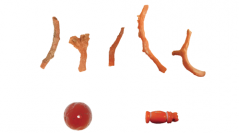

 Anthropozoologica
55 (1) - Pages 1-20
Anthropozoologica
55 (1) - Pages 1-20A number of archaeological salvage excavations conducted in Alexandria (Lower Egypt) by the Centre d’Études alexandrines have provided a corpus of around 2000 fragments of marine, freshwater and terrestrial invertebrates. These archeomalacological remains come from several occupation layers of the same district within the town, the Brucheion, dating from the end of the 4th century BC until the 6th century AD. After macroscopic observations and through a binocular microscope, the analysis of the malacofauna vestiges has provided previously unknown information regarding the exploitation of the aquatic environment by Alexandrians during antiquity. In addition, some residues of mineral material preserved on the shells have been analysed under a scanning electron microscope (SEM). This study sheds light on both consumption choices and on the variety of uses for shells (container, decoration, raw material) within the Alexandrian domestic context. Certain species from the Red Sea and the Western Mediterranean Sea provide new data on the movement of products of marine origin within Ptolemaic and Roman Egypt.
Alexandria, Lower Egypt, archaeomalacology, mollusc, Red Sea, Mediterranean Sea, food supply, trade, red coral, mother-of-pearl.